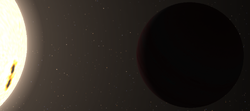GSC 02652-01324 is an orange dwarf main sequence star approximately 523 light-years away in the constellation of Lyra.

WASP-4b is an exoplanet, specifically a hot Jupiter, approximately 891 light-years away in the constellation of Phoenix.

WASP-8 is a binary star system 294 light-years away. The star system is much younger than the Sun at 300 million to 1.2 billion years age, and is heavily enriched in heavy elements, having nearly twice the concentration of iron compared to the Sun.
WASP-11/HAT-P-10 is a binary star. It is a primary main-sequence orange dwarf star. Secondary is M-dwarf with a projected separation of 42 AU. The system is located about 424 light-years away in the constellation Aries.
WASP-12 is a magnitude 11 yellow dwarf star located approximately 1410 light-years away in the constellation Auriga. WASP-12 has a mass and radius similar to the Sun and is known for being orbited by a planet that is extremely hot and has a retrograde orbit around WASP-12. WASP-12 forms a triple star system with two red dwarf companions. Both of them have spectral types of M3V and are only 38% and 37% as massive as the Sun, respectively.
HAT-P-4 is a wide binary star consisting of a pair of G-type main-sequence stars in the constellation of Boötes. It is also designated BD+36°2593.
XO-2 is a binary star. It consists of two components: XO-2S and XO-2N, both of which has two known exoplanets.
WASP-18 is a magnitude 9 star located 400 light-years away in the Phoenix constellation of the southern hemisphere. It has a mass of 1.29 solar masses.
WASP-19, formally named Wattle, is a magnitude 12.3 star about 869 light-years away, located in the Vela constellation of the southern hemisphere. This star has been found to host a transiting hot Jupiter-type planet in tight orbit.

HD 15082 is a star located roughly 399 light years away in the northern constellation of Andromeda. The star is a Delta Scuti variable and a planetary transit variable. A hot Jupiter type extrasolar planet, named WASP-33b or HD 15082b, orbits this star with an orbital period of 1.22 days. It is the first Delta Scuti variable known to host a planet.
HAT-P-33 is a late-F dwarf star. It is orbited by a planet called HAT-P-33b. A search for a binary companion star using adaptive optics at the MMT Observatory was negative.

Kepler-25 is a star in the northern constellation of Lyra. It is slightly larger and more massive than the sun with a luminosity 21⁄2 times that of the sun. With an apparent visual magnitude of 10.6, this star is too faint to be seen with the naked eye.
WASP-95 is a star 451 light-years away in the constellation Grus. With an apparent magnitude of 10.1, it is not visible to the naked eye. Its spectral type of G2 means it is a yellow sunlike star.
Kepler-29 is a Sun-like star in the northern constellation of Cygnus. It is located at the celestial coordinates: Right Ascension 19h 53m 23.6020s, Declination +47° 29′ 28.436″. With an apparent visual magnitude of 15.456, this star is too faint to be seen with the naked eye. It is a solar analog, having a close mass, radius, and temperature as the Sun. Currently the age of the star has not been determined due to its 2780 light-year distance. As of 2016 no Jovian exoplanets of 0.9–1.4 MJ have been found at a distance of 5 AU.
K2-3, also known as EPIC 201367065, is a red dwarf star with three known planets. It is on the borderline of being a late orange dwarf/K-type star, but because of its temperature, it is classified as a red dwarf.
K2-19 is an early K-type or late G-type main sequence star that is magnetically active, and has a light curve that exhibits variations in brightness of ~1%. It is located approximately 976 light-years away in the constellation Virgo. Three confirmed transiting exoplanets are known to orbit this star.
HD 146389, is a star with a yellow-white hue in the northern constellation of Hercules. The star was given the formal name Irena by the International Astronomical Union in January 2020. It is invisible to the naked eye with an apparent visual magnitude of 9.4 The star is located at a distance of approximately 446 light years from the Sun based on parallax, but is drifting closer with a radial velocity of −9 km/s. The star is known to host one exoplanet, designated WASP-38b or formally named 'Iztok'.
K2-24 is a metal-rich G3-type main sequence star larger and more massive than the Sun, located 560 light-years away in the constellation Scorpius. Two confirmed transiting exoplanets are known to orbit this star. An attempt to detect stellar companions using adaptive optics imaging at the Keck telescope was negative however later observations using lucky imaging at the Danish 1.54 m telescope at La Silla Observatory detected a possible companion at 3.8 arcseconds distance from K2-24. This candidate companion being over 8 magnitudes fainter than K2-24 and with a color temperature of 5400 Kelvin, is inconsistent with a bound main sequence companion.
HAT-P-30, also known as WASP-51, is the primary of a binary star system about 700 light-years away. It is a G-type main-sequence star. HAT-P-30 has a similar concentration of heavy elements compared to the Sun.
WASP-75 is a F-type main-sequence star about 980 light-years away. The star is much younger than the Sun at approximately 2.9±0.2 billion years. WASP-75 is similar to the Sun in its concentration of heavy elements.




